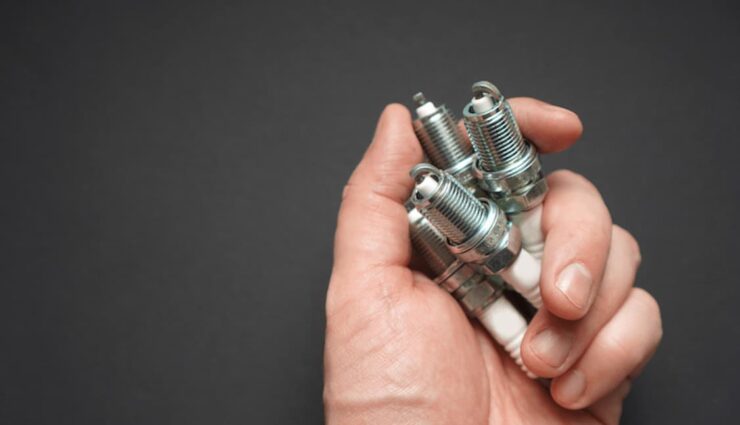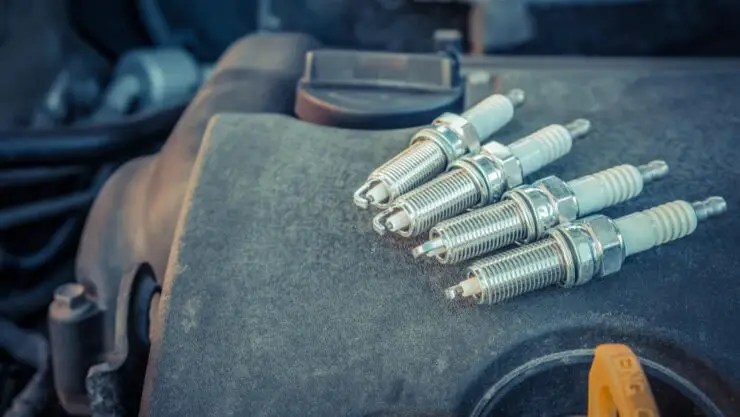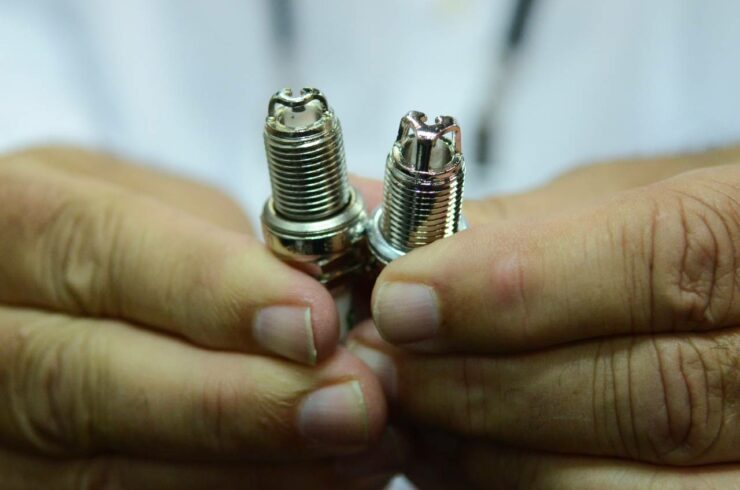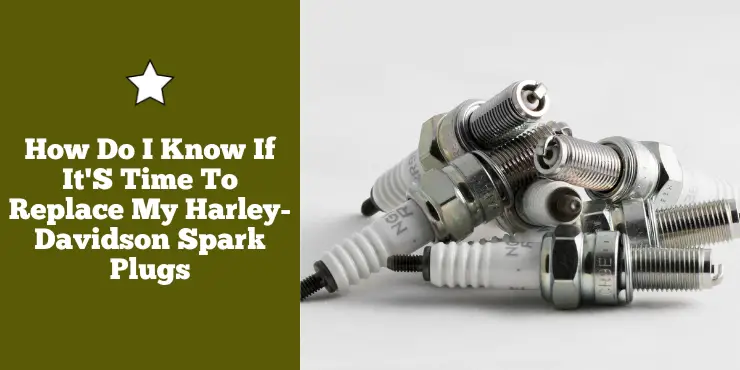Is your Harley-Davidson motorcycle not running as smoothly as it used to? Are you experiencing issues with acceleration or a decrease in fuel efficiency? If so, it could be a sign that it’s time to replace your spark plugs. Spark plugs are a crucial component of your bike’s ignition system, and over time, they can wear out and become less effective. But how do you know if it’s really time to replace them?
Replace spark plugs if you notice hard starting, rough idling, poor fuel efficiency, or diminished engine performance. Visual signs like carbon buildup or electrode wear also indicate replacement.
In this article, we’ll discuss some telltale signs that indicate your Harley-Davidson spark plugs may need to be swapped out. So, rev up your engines, because we’re about to dive into the world of spark plugs!
What is the role of spark plugs in a Harley-Davidson engine?
In the world of motorcycle engines, the spark plug plays a key role even though it often goes unnoticed. In a Harley-Davidson engine, this little component is responsible for a plethora of tasks. A spark plug is a simple yet essential component in an internal combustion engine, be it powering a car, a lawnmower, or a Harley-Davidson motorcycle. Its primary function will be to generate an electric spark that ignites the air-fuel mixture in the engine’s combustion chamber. This controlled explosion is what drives the engine’s pistons, generating power and propelling the motorcycle forward.
>>> Click here to read our review of the Best Harley-Davidson Spark Plugs <<<
Here is the role a spark plug plays in a Harley-Davidson engine –
#1. Igniting the air-fuel mixture
The most fundamental role of a spark plug is to ignite the air-fuel mixture in the combustion chamber. In a Harley-Davidson engine, as in any other internal combustion engine, this process is called ignition. When the spark plug fires, it produces a spark that jumps the gap between its central electrode and the ground electrode. This spark ignites the compressed air-fuel mixture, initiating the power stroke that drives the engine’s piston downward.
#2. Heat dissipation
Spark plugs are designed with different heat ranges to suit different engine applications. In a Harley-Davidson engine, which often operates at lower RPMs and produces substantial torque, the spark plug’s heat range is carefully chosen to ensure efficient combustion. A spark plug that is too hot could cause pre-ignition while too cold a plug can foul and misfire.
#3. Fuel economy and emissions control
Properly functioning spark plugs can contribute to optimal combustion, which enhances fuel efficiency. A Harley-Davidson engine with well-maintained spark plugs can achieve better mileage, reducing the frequency of refueling stops. Additionally, efficient combustion can result in lower emissions, helping the motorcycle meet environmental standards.
#4. Smooth idle and throttle response
A Harley-Davidson engine, such as the iconic V-twin design, relies on consistent and smooth operation. Spark plugs play a critical role in this by ensuring that each cylinder fires at the right time. Properly functioning spark plugs will contribute to a stable idle and responsive throttle, crucial for an enjoyable riding experience.
#5. Engine performance
Spark plugs also play a role in influencing overall engine performance. By maintaining the correct spark plug gap and selecting the overall type for your Harley-Davidson model, you’ll be able to optimize power delivery, torque, and overall performance. Some riders also choose high-performance spark plugs for achieving a little extra kick.
#6. Reliability and longevity of the engine
Well-maintained spark plugs are important for the reliability and longevity of your Harley-Davidson engine. Neglected or worn-out spark plugs can result in misfires, poor fuel economy, and engine damage. Regular inspection and replacement as needed will be vital for ensuring trouble-free riding.

How do I know if it’s time to replace my Harley-Davidson spark plugs?
Harley-Davidson bikes are known for their power and performance and keeping your bike in a top-notch condition will be paramount to a great riding experience. One of the components that contribute to your motorcycle’s performance is a spark plug. Spark plugs ensure smooth operation and power delivery. However, these machines can experience issues over time.
When spark plugs start to deteriorate or malfunction, they can end up affecting your bike’s operation. This is why you will wonder how do I know if it’s time to replace my Harley-Davidson spark plugs. There are certain symptoms that will help you know if it is time to replace the spark plugs in your bike. Here are some of the symptoms that tell you it is time to replace your Harley-Davidson spark plugs.
#1. Visible signs of wear
You can physically inspect the spark plugs to determine their condition. Remove the spark plug wires and carefully examine the plugs. Look for any signs of wear, such as black sooty deposits, fouling, or electrode erosion. These visible indicators will confirm that your spark plugs are in need of replacement.
#2. Rough idling
One of the main signs of faulty spark plugs will be noticeable change in your bike’s idle. If you notice that your bike is idling roughly or inconsistently, it may be due to spark plugs that aren’t firing correctly. A rough idle might feel like the engine is struggling to maintain a steady pace, and it is an indication that combustion in one or more cylinders is compromised.
#3. Rough engine performance
Faulty spark plugs can greatly impact your bike’s engine performance. As combustion becomes less efficient due to weak sparks or inconsistent ignition, you might notice a general roughness in your motorcycle’s operation.
This can manifest as vibrations, irregular idling, or a lack of smoothness in your throttle response. Rough engine performance will not only diminish your idling experience but can also be indicative of more severe engine issues if unaddressed.
#4. Hard starting or difficulty in ignition
Spark plugs are instrumental in the ignition process of your bike. A well-functioning spark plug will create a strong spark to ignite the air-fuel mixture, making starting your motorcycle effortless. However, as spark plugs wear out or become fouled, they might struggle to produce the necessary spark for ignition.
This can result in hard starting, especially when your bike is cold. Difficulty in ignition can be frustrating and might lead to repeated attempts to start your motorcycle, potentially causing undue wear on the starter rotor and other components.
#5. Decreased fuel efficiency
Another noticeable sign that your spark plug needs replacing is a significant drop in fuel efficiency. Spark plugs play a key role in igniting the air-fuel mixture within the engine’s combustion chamber. When they are worn or fouled, they might not produce a strong, consistent spark, resulting in incomplete combustion. This incomplete combustion results in wasted fuel, ultimately causing the bike’s mileage to suffer. If you find yourself visiting the gas station more frequently despite normal riding habits, it is time to consider inspecting and potentially replacing the spark plugs.
#6. Engine misfires
Engine misfires can be disruptive and concerning signs of spark plug issues. When spark plugs fail to produce a reliable spark, you could face momentary losses of power or surges in engine RPM while riding. These misfires can be particularly unsettling, affecting your motorcycle’s stability and responsiveness. Frequent engine misfires can result in poor acceleration, making it difficult to enjoy the smooth and powerful performance that Harley-Davidson is known for.
#7. Poor acceleration
Spark plugs play an important role in delivering the right amount of power to your bike’s engine. When they are compromised, you might experience sluggish or hesitant acceleration. If you find your motorcycle isn’t responding as it should when you twist the throttle, it can be due to faulty spark plugs.
#8. Increased emissions
Spark plugs also result in efficient combustion and emissions control. Faulty spark plugs can result in higher emissions, which could cause your motorcycle to fail emissions tests or run afoul of environmental regulations. This can be detrimental to both your riding experience and the environment.
How much is the lifespan of a spark plug in a Harley-Davidson bike?
To ensure your Harley-Davidson bike continues to deliver the powerful performance that it is known for, it is important that you pay attention to regular care and maintenance. The maintenance will extend to replacing the spark plug when the right time comes. Spark plugs play a key role in your bike’s ignition system and their condition greatly impacts its performance.
The lifespan of spark plugs can vary depending on several factors, including the type of park plug, your riding habits, the condition of your bike’s engine, and more. However, there are some general guidelines that will help you determine when it is time to replace the spark plugs.
Mileage
The most common indicator for spark plug replacement will be mileage. As a general rule of thumb, conventional copper core spark plugs last between 10,000 to 20,000 miles in a Harley-Davidson motorcycle. However, some modern iridium or platinum-tipped spark plugs can last up to 30,000 miles or more. It is important that you consult your motorcycle’s owner’s manual for manufacturer-specific recommendations regarding spark plug replacement intervals.

Riding conditions
The environment and riding conditions also affect the lifespan of your spark plugs. If you frequently ride in dusty or dirty conditions, your spark plugs might wear out more quickly due to contamination. Likewise, riding in extreme heat or cold can also affect their performance.
Engine health
The overall condition of your motorcycle’s engine can also impact the lifespan of your spark plugs. If the engine isn’t running optimally, it might put more strain on the spark plugs, causing them to wear out faster. Regular maintenance, such as tuning up your motorcycle’s engine can help extend the life of your spark plugs.
Maintenance tips to take care of the spark plugs in your Harley-Davidson bike
Your Harley-Davidson bike is a symbol of power, freedom, and the open road. To make sure you continue to enjoy the thrilling riding experience you’ve come to cherish, proper maintenance will be needed. You will need to take care of all components in your bike, including the spark plugs. There are certain tips you need to follow to ensure your bike performs as expected. Here are some of the maintenance tips to take care of the spark plugs in your Harley-Davidson bike.
#1. Regular inspection
One of the most effective ways to maintain spark plugs will be through regular inspection. Make it a habit to visually inspect the spark plugs periodically. Look for any signs of wear or damage. If you are noticing any abnormalities, it is important to address them promptly. Your spark plugs’ condition can provide valuable insights into your bike’s engine health.
#2. Follow manufacturer recommendations
Harley-Davidson offers specific guidelines for spark plug maintenance and replacement in your bike’s owner’s manual. You must follow these recommendations surrounding spark plug type, gap, and replacement intervals. These guidelines are tailored to your motorcycle’s engine, ensuring optimal performance.
#3. Keep the spark plug gap correct
The spark plug gap refers to the space between the ground electrode and the central electrode of the spark plug. It is a critical factor in ignition efficiency. Use a spark plug gap tool for checking and adjusting the gap to the manufacturer’s specifications when needed. An incorrect gap can result in poor combustion and decreased performance.
#4. Apply anti-seize compound
Consider applying a bit of anti-seize compound to the threads of your spark plugs. This will prevent the spark plugs from seizing in the cylinder head due to heat and corrosion. However, be cautious that you do not apply too much as excess anti-seize can foul the spark plug.
#5. Inspect spark plug wires
Aside from inspecting the spark plugs themselves, you should pay attention to the condition of the spark plug wires. Make sure that they are securely connected and free from damage or cracks. Damaged wires can result in erratic ignition and misfires.
#6. Proper torque
When installing new spark plugs or reinserting existing ones, use a torque wrench for tightening them to the manufacturer’s recommended torque specification. Over-tightening could damage threads while under-tightening can result in poor electrical contact.
#7. Use quality fuel and additives
The quality of the fuel you are using can also impact your spark plugs’ condition. High-quality, clean fuel can prevent carbon buildup and fouling. Additionally, using fuel additives as recommended by Harley-Davidson can help keep the engine and spark plugs clean and free of deposits.
#8. Replace spark plugs as needed
Even with proper maintenance, spark plugs eventually wear out. Pay attention to signs like decreased fuel efficiency, rough idling, engine misfires, and difficulty starting. If you notice any of these issues, you should consider replacing the spark plugs according to the intervals recommended by the manufacturer.

How to replace the spark plug in your Harley-Davidson bike?
Your Harley-Davidson bike is your pride and joy and to keep it running at its best, regular care and maintenance will be vital. Whether it is the tires, carburetor, or spark plugs. The latter plays a key role in the ignition process and replacing them can breathe new life into your Harley’s performance. However, you need to know the right steps before you can carry out the replacement and enjoy a smooth and powerful ride.
Before you dive into the replacement process, you need to gather the necessary tools and materials. Here are the tools that you need to gather –
#1. Spark plug socket
A spark plug socket is a tool designed to fit snugly around the spark plug’s hexagonal nut or terminal. It will ensure a secure grip on the spark plug, making removal and installation more straightforward. Choose a socket that has a rubber insert to protect the ceramic insulator of the spark plug.
#2. Wrench or ratchet
You will need a wrench or ratchet to turn the spark plug socket. The choice between a ratchet and a wrench will depend on your personal preferences and the accessibility of the spark plugs in your bike. A ratchet will provide more leverage and can be helpful when dealing with hard-to-reach spark plugs.
#3. Torque wrench
A torque wrench is a precision tool used for tightening the spark plugs to the manufacturer’s specified torque values. Proper torque is important for ensuring a secure seal and preventing overtightening, which may damage the spark plug or the engine’s threads.
#4. Anti-seize compound
Applying a small amount of anti-seize compound to the threads of the spark plugs before installation can prevent them from seizing in the cylinder head. This will be helpful when replacing spark plugs in an older Harley-Davidson bike.
#5. Dielectric grease
Dielectric grease is used for coating the porcelain insulator of the spark plug. It helps prevent moisture and dirt from contaminating the spark plug and the ignition system while also helping with the removal of the spark plug during future maintenance.
Once you have the tools and equipment, you will be in a position to get started with spark plug replacement. Here are the steps you need to follow to replace the spark plugs on your Harley-Davidson bike –
Step 1: Preparation
Make sure that your Harley-Davidson motorcycle is parked on a level surface with the engine turned off and cool to the touch. Disconnect the battery to prevent accidental electrical shocks or ignitions during the replacement process.
Step 2: Locate the spark plugs
Refer to your bike’s service manual to identify the location of the spark plugs. They are typically located on the cylinder heads. Remove the necessary components that obstruct access to the spark plugs, such as the air cleaner cover or air filter assembly.
Step 3: Remove and inspect the old spark plugs
Using the socket wrench and spark plug socket, you should carefully loosen and remove one spark plug at a time. Be cautious that you do not end up damaging the spark plug wires on the threads in the cylinder head.
Examine the old spark plugs for any signs of wear, damage, or fouling. These visual cues will provide insights into the health of your engine and potential issues. Check the spark plug gap using a gap tool. The gap needs to match the manufacturer’s specifications. Adjust the gap if needed.
Step 4: Prepare the new spark plugs
Apply a small amount of anti-seize compound to the threads of the new spark plugs. This step will be optimal but might make future removal easier. You should also apply a thin layer of dielectric grease to the inside of the spark plug boot to help with connection and prevent moisture intrusion.
Step 5: Install the new spark plugs
Carefully thread the new spark plugs into the cylinder heads manually by hand to prevent cross-threading. Use a torque wrench to tighten the spark plugs to the manufacturer’s recommended torque specification. Be sure that you don’t end up over-tightening as it can damage the threads or cause other issues.
Step 6: Reassemble and test
Reattach any components or parts that you removed to access the spark plugs. After that, you need to reconnect the battery. Lastly, start your bike and let it idle for a few minutes to test if the new spark plugs are working correctly.
FAQs
How can I tell if my Harley-Davidson spark plugs need to be replaced?
1. Look out for signs of poor engine performance, such as difficulty starting the motor or a decrease in power and acceleration.
2. Check for fouling or damaged electrodes on spark plugs during regular maintenance inspections.
3. Consult your owner’s manual for the recommended mileage intervals for spark plug replacement.
What are the common symptoms of worn-out spark plugs in a Harley-Davidson motorcycle?
1. Experiencing frequent misfires or engine backfires can indicate that your spark plugs are due for replacement.
2. Rough idling or a noticeable decrease in fuel efficiency could also be signs of worn-out spark plugs.
3. If you notice an increase in exhaust emissions or a decrease in engine power, it may be time to replace your spark plugs.
How often should I replace the spark plugs on my Harley-Davidson motorcycle?
1. The interval for spark plug replacement can vary depending on the model and year of the motorcycle.
2. As a general guideline, it is recommended to replace spark plugs every 10,000 to 20,000 miles or as specified in the owner’s manual.
3. Factors such as riding conditions and the type of spark plugs used may also affect the replacement frequency, so regular inspections are crucial.
>>> Read more about Harley-Davidson Spark Plugs <<<

